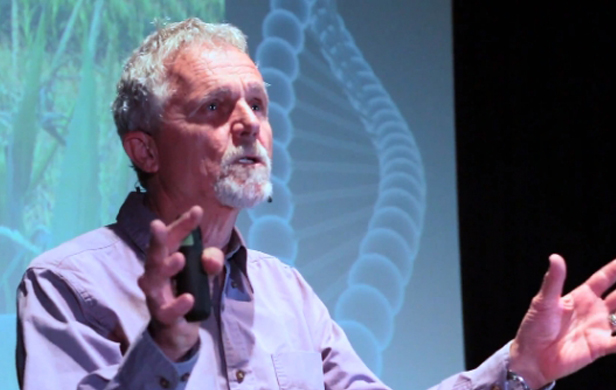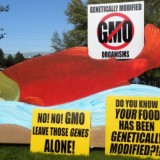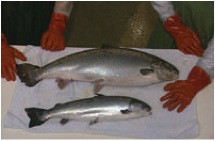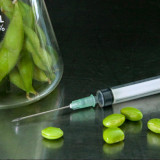
by Tsiporah Grignon
An interview with a whistle-blower doesn’t happen every day. I spoke with Dr. Thierry Vrain, a former soil biologist and genetic scientist who for 30 years worked for Agriculture Canada, and was the designated spokesperson to assure the public of the safety of GMO crops.
He retired ten years ago, and thus no longer received a paycheck dependent on a specific perspective. With time to read different viewpoints on GMO agriculture, Dr. Vrain experienced a gradual awakening, leading him to speak out passionately about the devastating effects of GMOs, both to the environment, and to the health of sentient beings.
My partner and I listened carefully as Dr. Vrain explained the basics of Genetic Engineering. Cells of every living organism consist of basically three major kinds of molecules: carbohydrates (made by plants through photosynthesis from sunlight) lipids, and proteins. The carbs and lipids do not move, but the proteins do. “Every molecule of protein can twitch, can make a movement…that molecule can twitch another molecule and can do something in the cell”. The intention of the genetic scientist is to engineer a protein in the plant to do something NEW in the plant.
For example, a new protein would be engineered to kill insects. The new gene is inserted into the plant, along with an antibiotic resistance gene. The outcome on the soil is basically that “every single engineered plant on the planet today has antibiotic resistance gene in it. That gene is in the genome, it’s in the roots, it’s in the soil and that can be picked up by the bacteria in the soil”. This is all happening globally on several hundred million acres of farmland planted with GMO crops.
In an effort to sell the public on the benefits of genetic engineering, the biotechnology industry came up with a special term to describe their new creation. The genetically modified plant is described as being “substantially equivalent” to a conventional plant. But if DNA has been altered, isn’t the plant different, and not equivalent?
Then Dr. Vrain explained how a scientist can hold a different view of nature. He asked us to imagine if by adding a human gene to corn, we could have 10,000 acres of corn growing insulin, and wouldn’t that kind of progress be very good? So if a tomato plant has a bacterial gene, and the fruit still looks and tastes like a tomato, to a scientist it is still a tomato plant, and therefore, the principle of substantial equivalence seemed natural to describe the genetically altered plant.
Now immersed in our science lesson, we learned about the results of the Human Genome Project, completed in 2002. Its goal was to sequence the whole genome of a person. Before this research, the science of molecular biology was based on the theory that the human body functions with about 100,000 proteins. DNA codes for proteins, and it was believed that each protein is coded for by one gene. Thus, if there are 100,000 proteins in our body, then there should be 100,000 genes.
However, the Human Genome Project concluded we have only just over 20,000 genes in our body. Suddenly, the one gene, one protein hypothesis no longer applied. It was an old paradigm. Since science is based on observation, here was a perfect example of yesterday’s scientific “fact” being obsolete.
As for the engineering process itself, Dr. Vrain told us that the scientist has absolutely NO control over where the gene will show up in the genome. Since this inserted gene doesn’t really belong there, it is impossible to predict what the gene is going to express! The conclusion is starkly clear: genetic engineering is an imprecise technology.
More troubling information emerged in our conversation. Genetic scientists needed to test for the safety of the inserted protein, to make sure it produces no adverse effects. Dr. Vrain explained that scientists started with the pure protein, meaning they tested it in a laboratory. They did not look for the protein IN the plant to see its effects on the plant or its environment. Using the old one gene one protein paradigm, scientists simply “assumed” that if the desired protein was inserted, it would get the effect they wanted, spawning the principle of “substantial equivalence”. We may imagine scientific research to be all about facts and evidence, but hearing about such an assumption shatters that illusion.
Furthermore, according to Dr. Vrain, scientists still believe the old paradigm, in contradiction of the evidence, because if they question the possibility of there being more than one protein in the plant other than the protein intended, that would make the plant different, and not substantially equivalent. And that would necessitate testing. Since 1996 the regulatory agencies have waived responsibility, saying “it’s completely substantially equivalent, there are no differences, we do not even need to look at them, and the companies don’t need to do any research”.
Instead, regulatory agencies trust scientific research. Dr. Vrain then shed light on the modus operandi of scientific research by explaining the expression “Publish or Perish”. Scientists need to make sure to publish their results. But in the late 80s, a significant change occurred. Scientists were allowed, and even encouraged, to seek corporate funding. Inevitably, once industry got involved, extra funding meant the scientist could enjoy a bigger lab. “If you were good and successful and you hit on a really good project, you could patent. So from Publish or Perish we went to Patent and Get Rich”.
It follows that funding will dry up if a scientist publishes results not acceptable to the scientific dogma or the corporate line. Moreover, the biotech corporations rarely do research themselves. Instead, they give very generous grants to scientists at universities, and what scientist will turn down good grants for his lab?
I had to inquire about Monsanto’s herbicide Roundup, proven not to be bio-degradeable as initially advertized. The active ingredient, glyphosate, actually starves the plant by being a chelator, making minerals in the soil unavailable to the plant. Still, Monsanto insists that Roundup is much less toxic than the herbicide it replaced, and ignores proof of the spread of super-weeds and super-bugs that have become resistant to the engineered technology. Dr. Vrain gave a sigh…“Yet the madness continues.”
I brought up the continuous battles to prevent the introduction of other GMO crops, such as alfalfa, which farmers definitively do not want, and the non-browning apple, which Dr. Vrain said began in his lab when he worked in Summerland. It was apple country, and “someone got the bright idea to silence the gene that browns the apple”. Geneticist David Suzuki’s message springs to mind regarding the perils of genetic engineering: Just because we can do something, doesn’t mean we should do it.
A frightening example is “terminator” technology, in which the seed or pollen becomes infertile. Do terminator genes pollinate? Is it possible to pass on infertility? Dr. Vrain answered yes, “We are talking famine here” because infertility can spread. Monsanto did buy the technology, for if seeds were infertile, people would be forced to buy their seed. Such a serious issue demands stopping Monsanto from ever bringing this idea out again.
Our sobering conversation was ending. Dr. Vrain mentioned an important document available online, a 120 page study released in June of 2012 called GMO Myths and Truths, a compilation of articles and government reports that question the safety of GMOs.
In conclusion, it takes courage and humility to let go of preconceived ideas and accept new data. Psychologists call it cognitive dissonance. Spiritual teachers refer to the letting go as disillusionment. Thierry Vrain has faced this most humbling human experience with dignity and grace.
But we are all being humbled now. We all eat for a living. Informed citizens worldwide know uncomfortable truths about GMOs and the biotech companies that profit from them. In this interview, we learned how genetic engineering is an imprecise technology, that safety tests are faulty, and that scientists abuse the scientific method for money by ignoring major sources of information. The informed also know that GMO crops contaminate other crops, and see it as a duty to resist Big Biotech’s techno/chemical war against nature. Dr. Thierry Vrain is now an organic farmer, a kindred spirit with peasant farmers worldwide, who know that the way to feed the world is to create and support small sustainable farms working with nature.






